
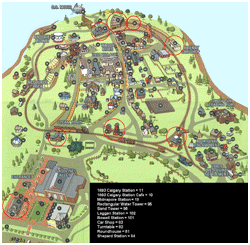 Table of Contents
Table of Contents
1. Heritage Park Overview
2. Calgary Station 1893
3. Midnapore Station 1910
4. Rectangular Water Tank
5. Sand Tower
6. Laggan Station 1891
7. Bowell Station 1909
8. Roundhouse
9. Turntable
10. Car Shop
11. Shepard Station 1910
12. Heritage Park Roster
13. News Stories
14. Historic Memos
15. Associated Web Sites
16. Fare
 Heritage Park Overview Heritage Park Overview
Heritage Park, located in Calgary, Alberta, is Canada's largest
living history museum. Meet fur traders, railway workers, and prairie town folk as you explore 127 scenic acres. Ride
an authentic steam train, enjoy the thrills of an antique midway, or set sail on Calgary's only paddle wheeler.
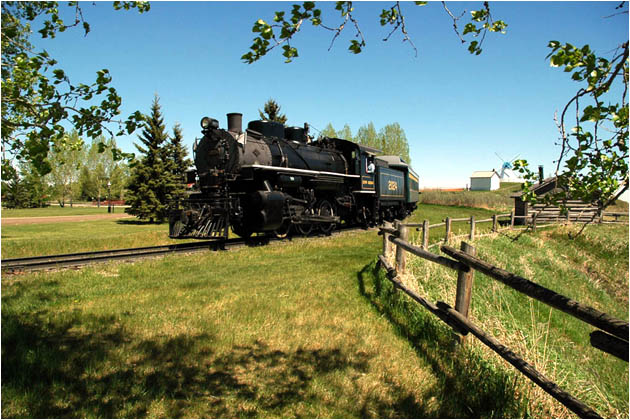
Lima built
Ex-Pacific Coast Terminals Ltd. number 4076 rounds the Park's loop of track near Midnapore
Station.
The Park's mission is to connect people with the settlement of Western Canada and to preserve and share Western
Canadian Heritage. Guests are welcomed in a safe, hospitable, heritage atmosphere. Programmes and special events
complement the Park's mission.
Heritage Park - How the West was once.
 Calgary Station 1893 Calgary Station 1893
The Canadian Pacific Railway Company was formed in February 1881 to take over the federal government contracted
sections upon completion and build the rest of the railway. It entered into a contract with Langdon, Shepard & Co.
of St. Paul, Minnesota, USA, to build the section of railway from Flat Creek (near Brandon) to Fort Calgary. It was
an important contract. Not only was it the largest contract awarded by the CPR, 672 miles, but it was the section of
track which would bridge the vast expanse of the prairies.
Prior to the coming of the railway Calgary was nothing more than a way station serving Edmonton, Fort Macleod, and
Fort Benton. The mode of public transportation was stagecoach with freight hauled by Red River carts.
On 15 Aug 1883 a construction train crossed the bridge over the Elbow River and moved forward to the
present site of the Palliser Hotel. It probably dropped off a boxcar to be used as Calgary's first station and construction office.
Early in 1884 the Canadian Pacific Railway's second station was constructed in Calgary. It was
a wooden two-storey structure of the same type built in other prairie towns but distinctive because of
its three chimneys. It also housed the telegraph office.
Due to the coming of the railway which opened up a supply line to the east the population of Calgary quickly rose
from about 100 to 1,000. With land sales and immigration the area was booming. By the 1890's, Calgary had grown
sufficiently to warrant a larger station to replace the original wood depot.
Constructed in 1893, a third station built of sandstone, similar in
construction to many homes undertaken in the city in 1893, was built to the east of the original wooden station. This
station was based on a design by art nouveau practitioner Edward Colonna.
The desire for a even another new station at Calgary, and the growing need for improved railway facilities in the
promising settlements of High River and Claresholm, convinced the Canadian Pacific Railway to dismantle the third
Calgary station stone-by-stone between 1910 and 1911. The station was reconstructed, with some
modifications, into two stations, with the west half of the old station moved to High River and the east half to
Claresholm, Alberta.
In 1911, this third station was once again replaced by a fourth station, an enlarged structure also made of
sandstone. This fourth station was torn down in 1966 to make way for the Palliser Square complex.
Heritage Park's 1893 Calgary Station is a close replica of CPR's first sandstone Station built in 1893. It's part of
the Park's expansion program that opened this season. The station will include a self-directed
orientation program in a sitting room for visitors awaiting the new, relocated trolley to take them into the main
village. Multimedia and informational wall panels will provide context and background on what's inside Heritage Park.
The station houses a cafe designed in the traditional CPR theme. Outside to the west a formal English garden is
planned.
A Calgary newspaper reports that the Selkirk, CP 5931, will be moved from its 14th Street cage to take up residence beside the
station.
 Midnapore Station 1910 Midnapore Station 1910
Between 1900 and 1940, the CPR used 8 standardized plans drawn by anonymous architects for approximately 3/4 of
their stations built in the prairie provinces. Between 1900 and 1910, just 5 designs were used. Some were extremely
simple, like the portable station at Bowell. Others were larger and more elaborate, such as the
"combination" stations, which housed a freight storage room, a waiting area, and an office under the same
roof. One hundred and ninety-three of these "combination" stations, including Midnapore, were
of Type A-2 design. Other stations based on this design can be found at Aldersyde, south of Calgary, and
at Strongfield, Saskatchewan. The Agent's office would be housed in a little bay on the front that allowed the agent or operator a clear view of the track in either direction.
The operator's living quarters consisted of a living room and kitchen behind the office, and bedrooms upstairs. The
CPR gave their stations fairly decent living quarters in order to attract married employees. Married men were
considered more responsible and less likely to quit than bachelors.
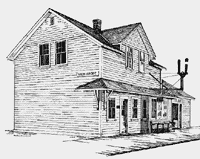 Midnapore station was built on the CPR line in 1910 at the hamlet of Midnapore, Alberta, just south of Calgary and now
within Calgary city limits. Midnapore sat on a 32-mile stretch of track between Calgary and Aldersyde,
where the line splits to go to Fort Macleod and Lethbridge. Midnapore was originally called Fish Creek but the village
postmaster, John Glenn, and his friend Samuel Shaw, changed the name when they found a letter addressed to the
postmaster in Midnapore, India, mixed in with Fish Creek's mail.
Midnapore station was built on the CPR line in 1910 at the hamlet of Midnapore, Alberta, just south of Calgary and now
within Calgary city limits. Midnapore sat on a 32-mile stretch of track between Calgary and Aldersyde,
where the line splits to go to Fort Macleod and Lethbridge. Midnapore was originally called Fish Creek but the village
postmaster, John Glenn, and his friend Samuel Shaw, changed the name when they found a letter addressed to the
postmaster in Midnapore, India, mixed in with Fish Creek's mail.
The CPR originally planned for the station to be manned by just a station operator, but upon the recommendation of
the influential Father Lacombe the position was upgraded to station agent. A station agent not only sold tickets,
checked baggage, and sent telegraph messages, he also directed trains and cars, and calculated shipping charges for
freight and express packages. Father Lacombe, a well-known missionary whose influence over the natives in
Alberta facilitated the peaceful settlement of the district, began an orphanage near the station in 1910. The CPR's
management appreciated his mediation, so they gave him free travel and freight transportation on the CPR for life.
Father Lacombe and the nuns visited the station frequently to receive visitors to the orphanage or to pick up supplies
shipped on the CPR. The only station agent at Midnapore was Herbert Cronk, who lived in the private quarters upstairs
with his wife. In 1912, passenger service was introduced between Calgary and Fort Macleod. Due to a wartime lack of
manpower, and a decreased amount of business, Midnapore station closed in 1918. Herbert Cronk served as station agent
in Cayley, Nanton, and Blairmore before his retirement in 1951. Until the 1940's or 50's the CPR allowed Midnapore
station to be occupied by a variety of caretakers in order to reduce the threat of burglary and vandalism. In 1964,
the building was sold to Heritage Park for $1 with the condition that the platform would be taken away and the site
cleaned up after the station's removal and move to its present location. Before 1972, it served as the administration
building for the Park, and since then it has been headquarters of the Historical Operations Department.
 Rectangular Water Tank Rectangular Water Tank
Steam engines use wood, coal, or oil to heat water in their boilers to produce steam, which is used to drive their
pistons which are connected by an complicated system of rods and levers to turn the wheels and control the motion.
Steam locomotives carry their own supply of water in a tender usually coupled semi-permanently to the
engine. To fill the tender water tanks were constructed at suitable locations. The capacity of an engine's water
tender varied between 2,000 and 11,000 gallons. Many smaller coal-fired engines had to fill up with water
every 50 miles, so the CPR installed water tanks at every other siding. Sidings were small train stations
approximately 10 miles apart. The capacity of water tanks varied between 4,000 and 40,000 gallons, depending on how
frequently engines filled up at that particular tank. Since locomotives use so much water, a reliable source of water
for the water tank was an important factor when the CPR decided which settlements got a siding.
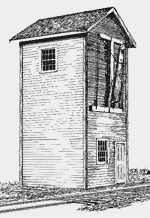 There are at least four types of wooden water towers utilized by the Canadian Pacific Railway during the steam era.
The most common type was the octagonal enclosed water tower containing a heater to prevent
the water from freezing during a Canadian winter. A ball located on a central mast at the top of the tank was
controlled by a float inside the tank thereby indicating the level of the water stored within the tank from quite a
distance away.
There are at least four types of wooden water towers utilized by the Canadian Pacific Railway during the steam era.
The most common type was the octagonal enclosed water tower containing a heater to prevent
the water from freezing during a Canadian winter. A ball located on a central mast at the top of the tank was
controlled by a float inside the tank thereby indicating the level of the water stored within the tank from quite a
distance away.
The next most common tank was the un-enclosed water tower typically found on
Vancouver Island where the milder winters didn't require the tank to be heated. There was also some
un-enclosed tanks in the East that were supported by concrete rather than timber framing.
The third type is this rectangular water tank found at Goldstream beside the
Esquimalt & Nanaimo Railway on Vancouver Island which was a subsidiary of the CPR.
And, finally, a rectangular enclosed water tower constructed here at Heritage Park. A prototype of this model was
once located in Rossland, British Columbia, on a short branchline serving the mines there.
Eventually, as time passed, wooden tanks were replaced with steel tanks as shown in this example from Carberry, Manitoba.
Water tanks would be filled by pumping water from a nearby river, or from a well beneath the tank. Prairie well water
was typically very hard, and caused scaling in locomotive boilers. This problem was mitigated by workmen at a
roundhouse adding water softeners.
By the 1920's, engines with a water capacity of 11,000 gallons came into service on Canada's railways. These did not
have to fill up with water as frequently as their predecessors did, so many of the smaller water tanks became
superfluous. By the 1950's, Canadian railways were switching to diesel engines, which did not require water, except
in smaller amounts for steam generators on passenger equipped units. However, instead of being destroyed, many water
towers were sold to local communities as domestic water supply facilities.
Heritage Park built their rectangular tower and tank in 1973 to supply the park's steam locomotives with water from
a 1902 CPR plan. CPR permitted the park to salvage plumbing components from a tower at East Coulee, Alberta, for use
in their construction.
The park's working steam locomotives, numbers 2023 and 2024, each have a water tender capacity of 3,000 gallons.
(Editor's note: While these two locomotives wear CPR livery they were never CPR locomotives.) When in use, one
of these engines will travel approximately 45 miles in a single day on the track at Heritage Park and use between
1,600 and 1,700 gallons of water. Every morning, whichever engine is being used for the day is filled from this water tower.
 Sand Tower Sand Tower
Many features of the Canadian landscape and climate can have an adverse effect on rail travel. Snow, fog, rain,
ice, and frost can make tracks slippery and dangerous. The steep grades through the Rocky Mountains can also cause a
locomotive to lose traction, especially if the locomotive is pulling a heavy train. Slippage can cause friction burns,
depressions, or flat spots on the rails, which can create vibrations and a rough ride on that section of track. If
these burns and depressions are not repaired eventually the entire section of track might have to be replaced. The
wheels of the locomotives using that section of track might also have to be replaced, or at least repaired more
frequently.
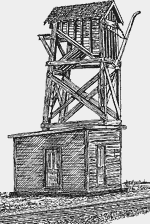 If a steam engine needs extra traction, sand can be used to help the wheels grip better. Sand from the sand dome,
usually located on top of a locomotive's boiler to keep the sand warm and dry, can be blown through a
1-inch pipe onto the rails directly in front of, or behind, the driving wheels, depending on which
direction, forward or back, the locomotive is heading. Sand for the sand dome would be obtained from a sand house,
usually located at a division point. Newly delivered sand to a sand house would be stored in a wet sand bin, and then
the "sandman", the sand house's keeper, would either use an auger or shovel it by hand into the furnace
room, located on the ground floor. In the furnace room, the sand would be dried and screened for stones. Then, using
either the yard's air compressor or compressed air from a locomotive, the sand would be blown up a delivery pipe into
the storage compartment at the top of the tower. This compartment would have a steeply sloped floor to make it easier
for the sand to be fed into the sand domes by gravity. The "hostler", a yard's locomotive servicing
employee, would position an engine by the sand house and lower the delivery or "sway" pipe into position
over the sand dome, which usually had a capacity of 45 gallons. He would then pull on a rope to open a valve and fill
the dome, then release the rope once the dome was full. As is the case at Heritage Park, a water tower was usually
placed next to the sand house so that the sand dome and the boiler could both be filled without moving the engine.
If a steam engine needs extra traction, sand can be used to help the wheels grip better. Sand from the sand dome,
usually located on top of a locomotive's boiler to keep the sand warm and dry, can be blown through a
1-inch pipe onto the rails directly in front of, or behind, the driving wheels, depending on which
direction, forward or back, the locomotive is heading. Sand for the sand dome would be obtained from a sand house,
usually located at a division point. Newly delivered sand to a sand house would be stored in a wet sand bin, and then
the "sandman", the sand house's keeper, would either use an auger or shovel it by hand into the furnace
room, located on the ground floor. In the furnace room, the sand would be dried and screened for stones. Then, using
either the yard's air compressor or compressed air from a locomotive, the sand would be blown up a delivery pipe into
the storage compartment at the top of the tower. This compartment would have a steeply sloped floor to make it easier
for the sand to be fed into the sand domes by gravity. The "hostler", a yard's locomotive servicing
employee, would position an engine by the sand house and lower the delivery or "sway" pipe into position
over the sand dome, which usually had a capacity of 45 gallons. He would then pull on a rope to open a valve and fill
the dome, then release the rope once the dome was full. As is the case at Heritage Park, a water tower was usually
placed next to the sand house so that the sand dome and the boiler could both be filled without moving the engine.
Until the 1960s all the sand for Canadian Pacific Railway locomotives in Western Canada came from the pits near
Empress, Alberta. Since then, it has mainly come from Bruderheim, Alberta. Sand is such an effective means of
providing traction that it is widely used by all sorts of trains, including the C-Trains on Calgary's
Light Rail Transit system.
Many sand houses were required across Canada during the period of steam locomotive operations. This example of a sand house and tower once existed
in the Victoria West yard next to the Russell's Roundhouse on the Esquimalt & Nanaimo Railway.
During the 1920s, the CPR built a sand tower and house at Alyth yards to a standard plan used since 1903 or 1904. Sometime during the
1960s it was moved to the yard at Red Dear, Alberta. It remained in use there until 1976, when the CPR decided to
donate it to Heritage Park.
Heritage Park's sand tower is not used at present. Besides the fact that the sand tower is missing the sand house, wet
bin, and other equipment necessary to function, the rail line through the Park does not have any steep grades, so sand
isn't really necessary. Furthermore, the train is rarely used during the winter months, so there is little chance that
the train would ever slip on ice or snow. In 1997 the tower was restored and painted.
 Laggan Station 1891 Laggan Station 1891
In 1883, the CPR's End of Steel reached what is now know as Lake Louise. The site was originally known as
"The Summit" but was soon renamed Holt City, after either the CPR's chief engineer in the rockies, Herbert
Holt, or his brother Tim, who was in charge of the commissariat at the construction headquarters at The Summit. Later
in the year, the site was renamed "Laggan" after a Loch with the same name in Inverneshire, Scotland, in
honour of Donald Smith. Smith, a Scotsman, was a primary shareholder and director of the CPR who later became known
as Lord Strathcona. By 1885, the End of Steel headquarters had moved to Donald, British Columbia, leaving Laggan to
the tourists.
In August of 1882, an outfitter and former North West Mounted Police (NWMP) man, Tom Wilson, was led by his Stoney
Indian guides to a lake they called Lake of Little Fishes. He was astounded by the lake's unparalleled beauty and
renamed it Emerald Lake. By 1884, the name had been changed to Lake Louise. Controversy exists about after whom Lake
Louise was named, but it is generally assumed that it was Louise Caroline Alberta, a daughter of Queen Victoria and
wife of the Marquis of Lorne, Canada's Governor General (1878-1883). In 1914, the name of the railway
station at nearby Laggan was changed to Lake Louise. The pristine wilderness attracted many tourists, and the CPR
built this railway station with them in mind. This station, and the one at Banff, which was also built to accommodate
the burgeoning tourist trade, were designed to have both an air of cosiness and a closeness to nature, to complement
the majesty of their mountain settings. The stations were made of peeled, round logs, and were given handsome concave
mansard roofs. This station had a waiting room, quarters for the operator, two bedrooms for tourists, and an office.
In 1909, a new log station was built, and the old structure was converted
to a baggage shed. In 1928 the station was moved to a nearby spur, where it continued to act as a storage facility.
In 1976, the structure was dismantled and moved to Heritage Park, where it was reassembled and restored to its
original beauty.
Laggan station gained international fame in 1886, after the publication of an article entitled "By Car and By
Cowcatcher" in England's Murray's Magazine written by Lady Macdonald, the wife of the Prime Minister, recounting
her adventures during their cross-Canada journey on the newly completed CPR. While their train was
switching engines in Laggan, Mrs. Macdonald insisted upon riding on the engine's cowcatcher through the Rockies. The
citizens of Laggan watched with some trepidation as the Macdonalds' train pulled out of the station, but Lady
Macdonald held on tightly and arrived safely at Port Moody. Or, so the story goes...
 Bowell Station 1909 Bowell Station 1909
On the prairies, the construction of the railway proceeded so quickly that the station builders were frequently
unable to keep up. They used portable structures like this one as temporary stations for the hamlets, villages, and
towns on the line. Even Calgary, already a prosperous town when the CPR arrived there in 1883, originally had a train
station like this one. The CPR used portable stations until the population growth of the nearby villages and the
corresponding increase in the use of the station necessitated the construction of a larger building. If a hamlet
shrunk or remained the same size, as did the hamlet of Bowell, the temporary station would continue to be used there,
sometimes for decades. These temporary stations cost very little to build, usually under $100, because of their
simple design and lack of adornment. They could be easily transported on a flatcar. These prefabricated stations,
which were often likened to boxcars without wheels, were small and usually had three rooms: a waiting room, a
ticket office, and accommodation for the station agent.
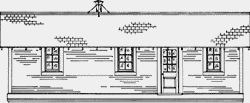 A wooden platform would normally be built outside to control
the ubiquitous prairie mud. Another temporary structure nearby would serve as a freight and baggage room. The
portable stations and freight buildings had no foundations. Instead they were simply placed on skids, which made them
easy to remove when a larger station was to be built. Permanent stations erected later, like Shepard or Laggan, could
be much more elaborate, with separate ladies' waiting rooms, a covered platform, and oak benches. Although these
stations were small and austere, they were positively palatial compared with the temporary stations used on the
Canadian Northern Railway line. Canadian Northern, another transcontinental railway company which was incorporated in
1899, used tents for their temporary stations and left their station masters to use an upturned crate for a telegraph
desk.
A wooden platform would normally be built outside to control
the ubiquitous prairie mud. Another temporary structure nearby would serve as a freight and baggage room. The
portable stations and freight buildings had no foundations. Instead they were simply placed on skids, which made them
easy to remove when a larger station was to be built. Permanent stations erected later, like Shepard or Laggan, could
be much more elaborate, with separate ladies' waiting rooms, a covered platform, and oak benches. Although these
stations were small and austere, they were positively palatial compared with the temporary stations used on the
Canadian Northern Railway line. Canadian Northern, another transcontinental railway company which was incorporated in
1899, used tents for their temporary stations and left their station masters to use an upturned crate for a telegraph
desk.
The hamlet of Bowell was named after Sir Mackenzie Bowell, a senator and Canada's Prime Minister between 1894 and
1896. Bowell was located north-west of Medicine Hat on the main CPR line. Bowell became Prime Minister
after the sudden death of Sir John Thompson. Dissatisfied with his leadership, half of Bowell's ministers resigned in
January of 1896. Bowell himself resigned in April of the same year, and was succeeded by Sir Charles Tupper. Like many
small settlements, Bowell never grew large enough to justify the construction of a bigger station, and eventually the
CPR closed the station. In 1964 the CPR gave the station to Heritage Park, where it was converted into a washroom.
It was near Bowell that the famous Phantom Train incident occurred in 1908.
 Roundhouse Roundhouse
On the CPR line there was a division point every 125 miles and at every division point there was a roundhouse. It
was at the roundhouses that engine maintenance and light repairs would take place. When a train arrived at a division
point, the locomotive would be uncoupled and the fireman and engineer would move it to the shop service tracks. The
engine's crew would "book off" and the engineman would give the roundhouse foreman a list of repairs to be
done called the "work report". A hostler would move the engine over the ash pit where the fire was dumped
and the ash pans cleaned, and then fill the tender with coal and water. The engine would then be moved onto the
turntable and put into an empty stall in the roundhouse. The foreman would check the work report and delegate tasks
to his specialist machinists, boilermakers, pipe fitters, blacksmiths, and tinsmiths. As each specialist completed
his task, he would initial his part of the work report. When the foreman was satisfied that the work was complete, he
would release the engine for service. The hostler would then heat the engine up and move it outside to the ready
track.
The roundhouse would be in use 24 hours a day, 7 days a week. Men in the roundhouse worked 12 hour days, 6 days a
week. On cold days the engines were allowed to heat up inside the roundhouse. This created a fair amount of steam,
which condensed into thick, sooty ice that had to be chopped off the doors with an axe. The interiors of the
roundhouses were poorly lit, foggy, and sooty, which wreaked havoc with the lungs of the workers. Furthermore, there
were few safety procedures to follow, and accidents were commonplace. Many men disliked working inside the roundhouse,
but they were often unable to quit. Most of the workers had signed on as indentured apprentices, and were
contractually obliged to remain with the CPR for at least 5 years.
Heritage Park built this roundhouse in order to provide proper facilities for the repair and maintenance of their
locomotives, and to showcase some rail exhibits indoors. The Park decided to base the roundhouse on the CPR's Standard
Plan No. 5 which was adapted by the architectural firm of M.P. Werner Engineering Ltd. Construction was completed by
Watson Construction Ltd. in 1981. The Alberta Heritage Fund provided funds for the construction of the roundhouse in
honour of Alberta's 75th anniversary as a province in 1980. Although this plan is for a 10-stall
roundhouse, due to spatial and economic limitations, the Park reduced it to 6 stalls. The plan was further adapted to
have electricity, heat, and a modern ventilation system, to make the roundhouse more comfortable for visitors and
workers. The two stalls separated from the rest by a firewall are used for engine repairs, and are not visible to the
public for safety reasons. The Park can do about 95% of its locomotive repairs and maintenance right here. The other
four stalls are used to house the snow plow, Jordan spreader, Caboose No. 437358, and locomotive 2018, also known as
the "Canmore Goat". The structures descending from the ceiling are called "smoke jacks". When a
locomotive is parked in the roundhouse, its smokestack is positioned under a smoke jack, thereby venting any smoke
directly outdoors. The smoke jacks in the repair and maintenance area are functional, however the ones on the display
side are just mock-ups.
 Turntable Turntable
Although they are rarely mentioned in railway literature, turntables play a vital part in the efficient
functioning of a division point. They provide access to the roundhouse, where maintenance on locomotives take place,
and they turn engines so that they are facing the right direction for a new assignment. A single locomotive or an
entire train can also be reversed using a wye, a Y-shaped track configuration.
A turntable sits in a circular pit with a diameter equal to the length of the turntable, which was usually between 55
and 100 feet. In areas that receive heavy snowfall, the pit often contained steam pipes to melt snow that might fill
the pit and hinder the turning of the table. As engines got longer, the turntables and pits had to get longer too.
When turntables were smaller they could be rotated using the "Armstrong" method, which was simply using a
group of men to turn it manually. However, as the tables got bigger, men could no longer turn the tables themselves.
Steam power, an electric motor, or compressed air from either a locomotive or a compressor would be used to rotate the
table. Larger engines had to be balanced perfectly on the table, or the table would tilt and the motor would be unable
to turn it. Although they were vitally important to the divisional points of Canada's railways, few people took much
notice of turntables. Only when one broke down, wreaking havoc with schedules and timetables, did people notice how
important they were.
The history of Heritage Park's turntable is subject to some debate. To the best of the Park's knowledge, it was built
in 1907 or 1933 at the Canadian Foundry Company in Winnipeg. The turntable was built as a 70 foot half deck plate
girder turntable out of steel that probably came from the Carnegie Illinois Steel Corporation. It was first installed
at the train yard in North Bend, B.C., 60 kilometres north of Hope. In 1927, it was relocated to Arrowhead, B.C., on
the Arrow Lakes. Here it replaced a shorter 55 foot table, which was unable to accommodate some of the larger
locomotives coming into service at that time. In 1968, Arrowhead was flooded due to the construction of the new Hugh
Keenleyside Dam near Castlegar, which raised the level of the Arrow Lakes. The turntable was removed and installed in
Sicamous, replacing a table built in 1900. In 1981, the CPR gave the table to Heritage Park. It was set up behind the
roundhouse in order to give rolling stock access to the repair shop and display areas of the roundhouse. The grey
mechanism to the left of the table is the air-operated motor that turns the table.
 Car Shop Car Shop
Most railways in Western Canada, including the CPR, placed a divisional point on their tracks every 125 miles or
so. That being the distance a locomotive could travel in 1 day without stopping to refuel. Each divisional point was
provided with a medium-sized station, yard, engine shed, water tower, and a coal shed. It was at these
divisional points that a steam locomotive would take on water, have its coal tender refilled, pick up or drop off cars
from the yard, and possibly be coupled to another engine for a trek up some steep grade. Every other divisional point
had a repair shop. At these shops skilled workmen fixed both cars and engines.
Calgary itself had a large number of CPR shops, covering 213 acres at Ogden. By 1885, Calgary was already a major
distribution centre for the CPR in south-central Alberta. In 1912, Calgary's civic leaders convinced the
CPR to build their repair shops just outside Calgary in exchange for streetcar service to the site, and the
construction of access roads and bridges. Ogden shops employed 3,000 people, making them Calgary's biggest private
employer. Ogden shops remained one of the largest contributors to Calgary's economic development until the oil boom of
the 1940s.
Heritage Park possesses several antique railcars that need to be protected from the elements in order to ensure that
they are preserved for the enjoyment of future generations. Rain, snow, hail, extreme temperatures, changes in
humidity, and even sunshine can all make vintage railcars deteriorate much more quickly than they would if protected
from these natural hazards. Recognizing this, the Park built the Car Shop to protect some of the cars in the greatest
danger of deteriorating if left outdoors. This building is based on late 19th century or early 20th century CPR car
repair shops. The high clerestory windows would have provided daytime lighting for the men working inside. Some
concessions were made to modern convenience including interior lighting, insulated walls, a modern heating system, and
a concrete floor. These changes both enhance the comfort of visitors to the Car Shop and help preserve the rolling
stock exhibits.
Besides being a storage facility, the Car Shop also functions as an interesting exhibit during the summer months. It
contains displays pertaining to various aspects of the railway in Western Canada, and houses exhibits during Heritage
Park's annual Railway Days. Currently the Car Shop houses Colonist car No. 2658, Business car No. 5 (Rupertsland),
Langdon & Shepard car No. 76 (a construction car), Business car No. 100 (York), and Suburban car 141.
 Shepard Station 1910 Shepard Station 1910
Between 1901 and 1911 nearly a million immigrants arrived at Western Canadian train stations like this one. For
most, the train station would represent the end of a long, gruelling journey, and the start of a new life. It would
remain a prominent fixture in their lives because it was at the train station that they would receive
mail-order shipments and relatives joining them in the West. The CPR built so many stations that it could
not afford to create a new design for each one. Therefore, the CPR used 8 standardized designs between 1900 and 1940
for the construction of the vast majority of their stations in Western Canada. Even though these stations were hardly
unique, they served their purposes so well that many were in use until the 1970s.
During the 1880s the hamlet of Shepard was a full day's journey east of Calgary. Located where the CPR line splits
to go northeast to Strathmore, and southeast to Gleichen and Medicine Hat, Shepard was named after David C. Shepard of
St. Paul, Minnesota, USA. David Shepard and his partner General Robert Bruce Langdon of Minneapolis created a
contracting business called Langdon, Shepard & Co. In the spring of 1882, the Canadian government awarded this
company the contact to build the CPR across the prairies. Langdon and Shepard hired 3,000 men and procured 4,000
horses to build their section of track. They started at Flat Creek, near the Manitoba border and stopped at Calgary in
August of 1883, after laying approximately 675 miles of track in 15 months. The work proceeded at a phenomenal pace.
During June of 1883, for instance, the company laid 67 miles of track. David Shepard also invented
2-storey boarding cars that made it unnecessary for railway workers to set up a new camp every night.
Both David Shepard and Robert Langdon had towns named for them on the CPR line, Langdon being just a few miles east of
Shepard. This station was built in Shepard in 1910, and was probably the second built there. Records indicate that the
first was just a small, unmanned "flag station". Except for its enlarged baggage room, this station
conforms to CPR Standard Plan No. 5. Over a hundred stations of similar design can be found across the prairies.
Although the No. 5 design seems plain and straightforward, it is also economical and efficient. Other CPR stations of
the same design were located a Bow Island, Alberta, and Hanley, Saskatchewan. The Grand Trunk Pacific Railway also
built a station remarkably similar to the No. 5 design, located at Nokomis, Saskatchewan.
In 1970, the CPR retired this station and donated it to Heritage Park for a fee of $5. Glenmore Community Association
donated $45,000 for its removal and restoration at Heritage Park. The CPR gave Heritage Park a choice between this
station and the one at Stavely, Alberta. Besides being in better condition, this station was nearer to the Park and
had a greater historical connection to Calgary, so it was chosen. At Heritage Park it serves as a train station,
washroom, and snack bar. The second floor, which was originally the station operator's living quarters, has served as
a workshop and a storage place for antique books.
 Heritage Park Roster Heritage Park Roster
Equipment
|
Source
|
Built
|
CP 2018 0-6-0 Switcher class U3c
|
Canadian Pacific Railway
|
1905
|
PCT 2023 0-6-0 Switcher
|
Pacific Coast Terminals Ltd.
|
1942
|
PCT 2024 0-6-0 Switcher
|
Pacific Coast Terminals Ltd.
|
1944
|
CP 5931 2-10-4 Selkirk class T1c
|
Canadian Pacific Railway
|
1949
|
CP 7019 S2
|
Canadian Pacific Railway
|
1944
|
Construction Car 76
|
Canadian Pacific Railway
|
1882
|
CP 100 York
|
Canadian Pacific Railway
|
1901
|
CP 5 Rupertsland
|
Canadian Pacific Railway
|
1902
|
MF&M 62 Coach
|
Morrissey, Fernie & Michel Railway
|
1885
|
MF&M 63 Coach
|
Morrissey, Fernie & Michel Railway
|
1902
|
CP 2658 Colonist Car
|
Canadian Pacific Railway
|
1912
|
CP ? Suburban Coach
|
Canadian Pacific Railway
|
1907
|
CN 15097 Open Observation Car
|
Canadian National Railways
|
1912
|
CP 436209 Wood Caboose
|
Canadian Pacific Railway
|
1912
|
CP 437359 Steel Caboose
|
Canadian Pacific Railway
|
1949
|
CGTX 6010 Tank Car
|
CGTX Inc.
|
1920
|
CP 19752 Box Car
|
Canadian Pacific Railway
|
1913
|
CGTX 6010 Tank Car
|
CGTX Inc.
|
1920
|
HP 221 Flat Car
|
Heritage Park replica
|
1973
|
MF&M 53 Flat Car
|
Morrissey, Fernie & Michel Railway
|
?
|
CP 3774 Railway Post Office
|
Canadian Pacific Railway
|
1918
|
CP 404687 Box Car
|
Canadian Pacific Railway
|
1923
|
CP 418181 Flat Car
|
Canadian Pacific Railway
|
1912
|
CP 412409 Service Car
|
Canadian Pacific Railway
|
1923
|
NAR 20006 Stock Car
|
Northern Alberta Railway
|
1923
|
CP 414328 Steam Wrecker
|
Canadian Pacific Railway
|
1920
|
CP 415722 Tender Wrecker
|
Canadian Pacific Railway
|
1907
|
CP 400884 Snow Plow
|
Canadian Pacific Railway
|
1911
|
CP 402829 Jordan Spreader
|
Canadian Pacific Railway
|
1913
|
Additional Information
Standard track gauge is 4 feet 8 1/2 inches.
Length of main track is 4,300 feet.
Main track was installed in 1964.
Wye: Like a turntable, the wye can be used to reverse the direction of rolling stock. However, unlike
the turntable, the wye does not require much complicated machinery, just three switches and a substantial amount of
track. Wyes take up much more area than turntables and even entire trains may be turned around if the wye is of
sufficient size. This is useful because many rail companies, like the CPR, require the cars in their passenger trains
to run in a specific order; day coaches forward, sleepers behind, and the observation car at the tail end. There are
wyes at the CPR main terminals in Montreal and Vancouver (Vancouver's Drake Street yard had a loop of track circling
the roundhouse for reversing the "Canadian".). Heritage Park's wye was built in 1970 behind Laggan
Station.
Trestle: Although the better-known trestles on Canada's railways all serve the same purpose
of bridging gaps or chasms they are much larger than Heritage Park's trestle. Timber trestles could be erected
inexpensively and fairly quickly, and many still stand today. However, most of the smaller ones have been replaced by
earth fills and culverts, and the larger ones by concrete and steel structures. The water barrels located next to, or
on the trestle, were for fire fighting, in case sparks from a locomotive should start a fire on the dry timber.
Heritage Park's trestle was built in 1973 as a gift from Canadian Pacific Railway. The railway companies custom
designed each trestle to fit a particular site, so it would have been impractical for Heritage Park to transfer an
existing one and retrofit it.
 News Stories News Stories
1 Oct 1951 - Town Station Agent is "Very Useful
Fellow
21 Sep 1977 - Ghostly Overture for a Tragedy
23 Nov 1977 - Seniors Take Old Station
9 Dec 1981 - A Victim of Progress Station has a New
Role
1 Feb 1987 - Heritage Park a "Great" Folk
Museum
1 Nov 1987 - Lloydminster Station a "Priceless"
Home
1 Jan 1988 - Full Range of Stations Trailed Railway
Builders
3 Apr 2009 - Grand Opening Set for $65M Expansion
 Historic Memos Historic Memos
31 Oct 1981 - Interview with N.R. Crump
Re: Roundhouse
1982 - Proposed Plaque 1982 In the Roundhouse
 Associated Web Sites
Associated Web Sites
Canadian Pacific Railway
Canadian Pacific Archives
Country Railroad Station of Manitoba, The
Glenbow Museum, The Great CPR Exposition
John M. Egan, A Railway Officer in Winnipeg,
1882-1886
Canadian Pacific Historical Association (CP SIG)
Heritage Park


|
|